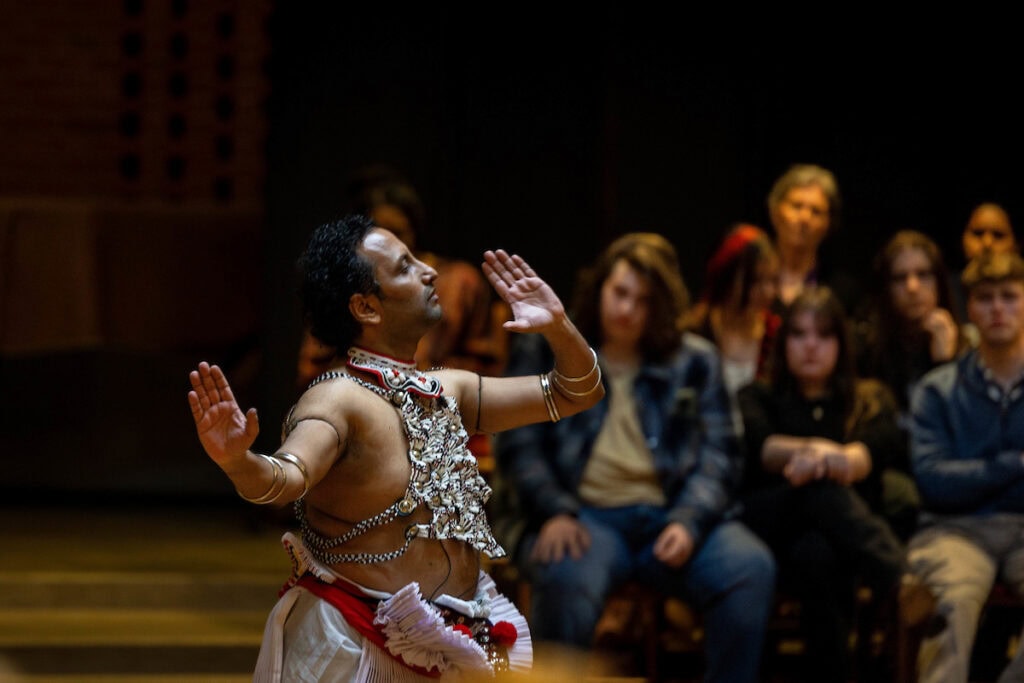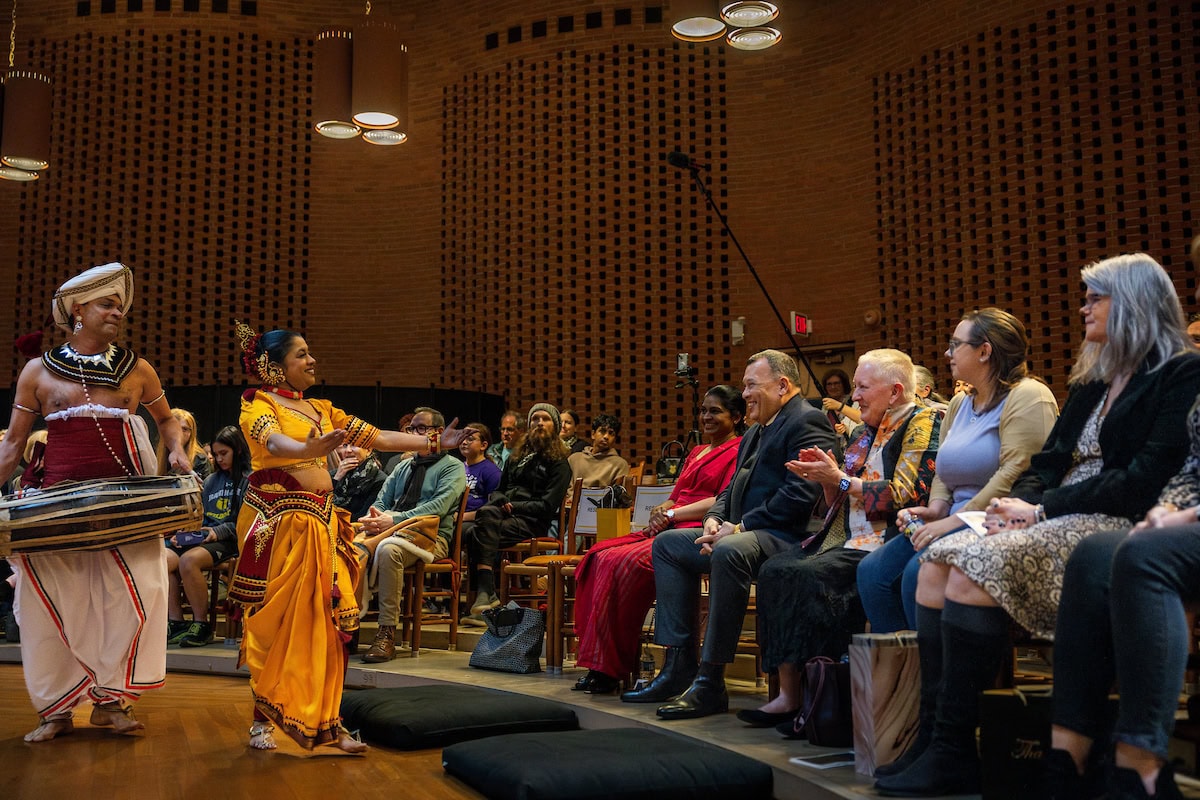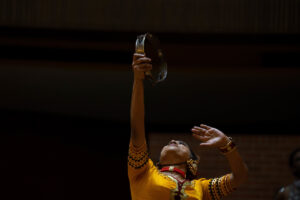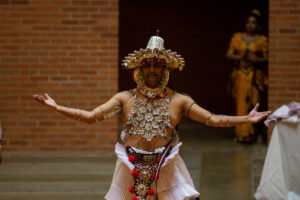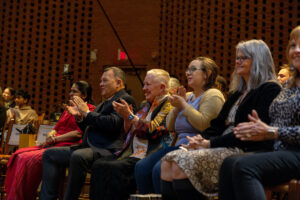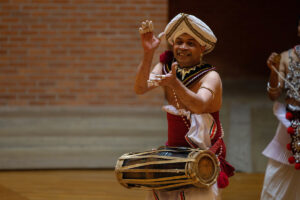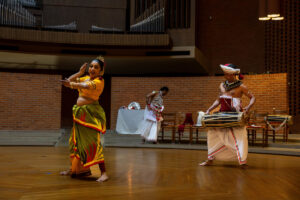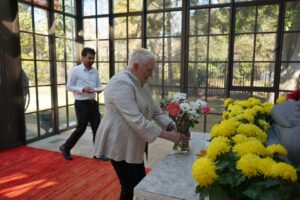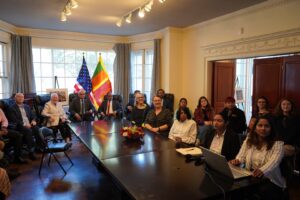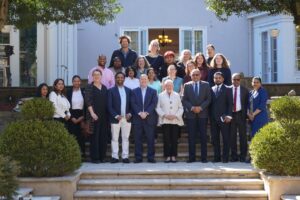Connecting Cultures: Randolph’s Quillian Visiting International Scholar shares Sri Lankan heritage
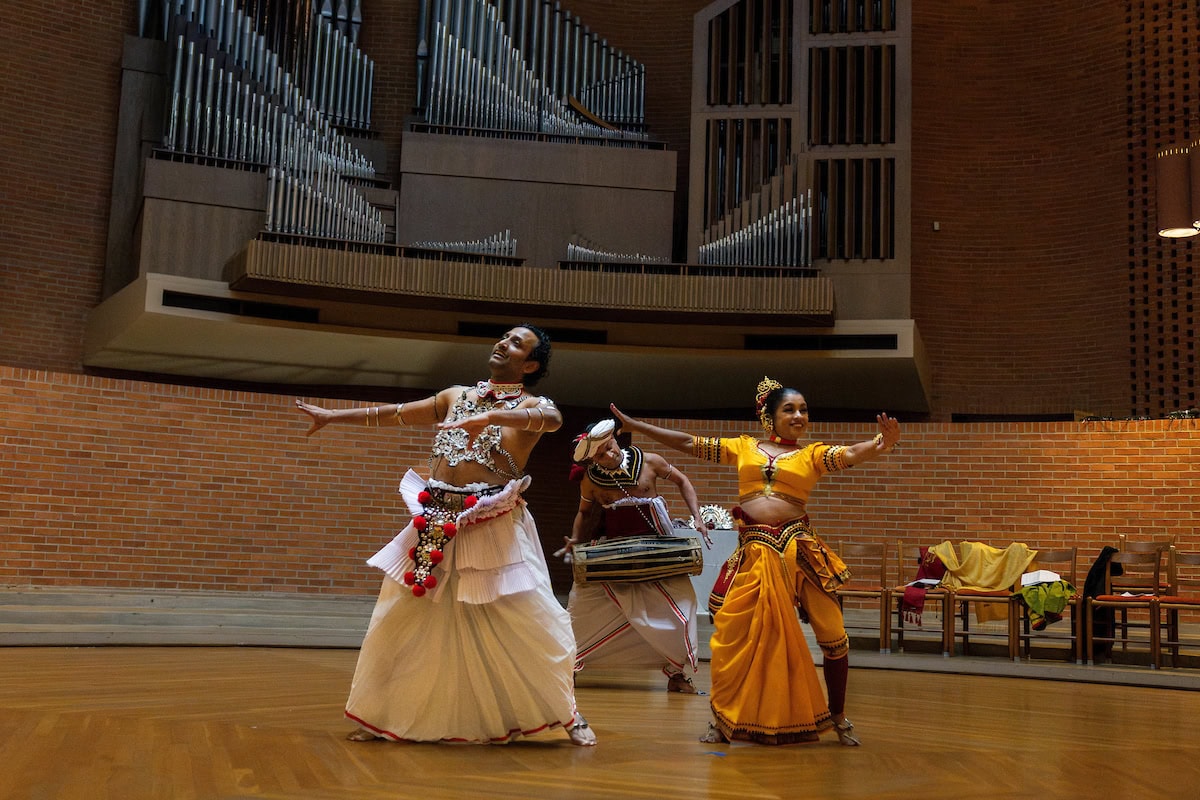
From left, Sudesh Mantillake, Chinthaka Bandara, and Vajira Mantillake perform during February’s Quillian Symposium on Sri Lanka.
Applause echoed in Houston Memorial Chapel as Vajira Mantillake, moving gracefully in a bright-yellow, traditional Sri Lankan saree-like dress, circled the performance area while encouraging the crowd’s participation.
Drums, courtesy of percussionist Chinthaka Bandara, and the twinkling of bells worn on the ankles of Sudesh Mantillake, the College’s 2024-25 Quillian Visiting International Scholar, soon added to the melody.
The trio performed Kandyan dance, the unofficial national dance of Sri Lanka, on campus in February during the College’s Quillian International Symposium on Sri Lanka.
Clad in the traditional costume of the Kandyan dances, including a beaded breastplate and bangles up and down his arms, Sudesh Mantillake told the audience, “We are here to have a dialogue.”
Mantillake refers to the piece, “Contextualizing My Devil Dance,” as a docu-dance, during which he time travels through pre-colonial, colonial, and post-colonial times in his native Sri Lanka.
“In his performances, Sudesh takes elements of traditional Kandyan dance, dissects, and then reassembles them into a performance,” Presidential Fellow Suzanne Bessenger said, “showing that even ancient forms of dance are never stagnant.”
Sri Lanka endured 400 years of colonial occupation—the Portuguese in the 16th century, followed by the Dutch and, lastly, the British, who ruled until 1948.
Though now widely recognized as a theatrical art form, Kandyan dance was initially rooted in spiritual and restorative practices. But when British colonizers and missionaries encountered these rituals, they misinterpreted them as “devil worship,” stripping them of their true purpose and cultural significance.
“They began viewing it from their own limited religious points of view,” Mantillake said. “They began to think, ‘If they’re not worshipping our god, they must be worshipping the devil.’”
His performance traced that journey—examining how Kandyan dance was misunderstood, how colonialism reshaped its perception, and how it evolved through nationalism and globalization into its current form.
“This is a piece of art with a documentary, narrative element where I talk about the history,” he explained before the event. “But, at the same time, we are embodying the dancers’ lives as well.”
Once Sri Lanka gained its independence from the British, its people began searching for their national identity as a newly independent nation. “So they looked into the past,” Mantillake said.
His goal with the piece was to highlight the history and explore how a culture or art form can be misinterpreted—and, ultimately, how it can be reclaimed and better understood.
“We do Kandyan dance to celebrate our shared heritage, resist colonialism, and celebrate our differences,” he said. “We do Kandyan dance to heal us–and to heal you.”
Knowledge across borders
As Randolph’s Quillian Visiting International Scholar this year, Mantillake incorporated Kandyan dance into the College’s dance curriculum and included students in the winter performance.
It’s the first time it has been taught in a college setting for academic credits, something for which Mantillake was particularly excited.
“As a Sri Lankan, I’m really proud of that, and how welcoming Randolph is to international artistic expression,” he said. “The students have been really engaged. One of the approaches I’ve been using, and this is something I really believe, is teaching the context behind the dances. You can’t just learn the techniques without the history.”
Stephanie Swithers ’25 was among Mantillake’s students and performed alongside him in February.
“He brings a positive and inviting energy into the studio, alongside his wife, Vajira,” said Swithers, who majored in elementary education major and minored in dance. “In each class, we delved deeper into the dance’s fine techniques and style and challenged ourselves.”
She loves that Randolph offers opportunities for students to learn about and immerse themselves in different traditions.
“While dance is often not verbal in performance, it is a way to communicate with others,” Swithers said. “Allowing not only my brain, but also my body, to experience Sri Lankan culture and dance helped me understand the culture from a deeper perspective.”
Randolph’s Quillian Visiting International Scholars Program, originally called the William F. Quillian, Jr. Visiting International Professorship, began in 1996, named after the sixth president of the College and one of its strongest advocates for international studies.
Under President Sue Ott Rowlands’ leadership, the College has relaunched the program. It will alternate years with the Pearl S. Buck Award, which was also relaunched after a hiatus last year.
“I’m happy to be reviving the Quillian program, and I’m extremely happy that Sudesh has been our first visiting faculty member,” Ott Rowlands said. ‘His contributions to the campus have been numerous during this academic year, and we will miss him terribly when he leaves us.”
As part of his duties, Mantillake also organized the February symposium on Sri Lanka to explore his country’s culture, history, and resilience through workshops, academic discussions, and a final performance that weaved it all together.
“I consider myself a scholar-artist,” he said. “I grew up as a dancer, then I went into academia. I’m really bridging these two spheres.”
Sri Lankan Ambassador Mahinda Samarasinghe attended the performance in Houston Memorial Chapel and spoke beforehand, praising the relationship between the United States and Sri Lanka.
He and Ott Rowlands also exchanged gifts.

President Sue Ott Rowlands and Sri Lankan Ambassador Mahinda Samarasinghe presented gifts to each other during the performance.
It all tied in with Mantillake’s inspiration for the symposium: the philosophical concept of the rhizome, a network of connections between elements.
“It’s the idea of sharing knowledge across borders,” said Mantillake, who took a sabbatical from his role as permanent faculty member at the University of Peradeniya in Sri Lanka to come to Randolph. “It’s not science. It’s not art. It’s not one thing. In life, everything is connected. We can’t divide what is art, what is knowledge, what is feeling.”
‘Why We Dance’
A documentary crew followed Mantillake during the symposium, as he taught a master class in Kandyan dance and performed in Houston Memorial Chapel.
Mantillake is the field producer and cultural consultant on the film, Why We Dance: Ritual, Performance, and Healing in Post-War Sri Lanka.
Filmmakers Susan Reed, a professor at Bucknell University, and Wilton Martinez, a visual anthropologist at the University of Maryland, have traveled the world for the film, following traditional and contemporary dancers and exploring the use of dance for healing and community building.
“I’m in the film too, as someone who is practicing Kandyan dance and is critically engaged with it as a performer and scholar,” Mantillake said. 
Students in the College’s film and video program assisted with the shoot, bridging the gap between classroom learning and real-world experience.
“Hands-on experience is invaluable for our students,” said film and video professor Dusty Abernathy. “Being part of a professional documentary shoot gives them real-world insight into the filmmaking process—collaborating with a crew, problem-solving on set, and seeing how a project comes together from behind the camera.”
A new beginning
Mantillake’s time at the College has wrapped up, but the connections he’s made here remain.
In May, he will lead a group of students and faculty on a study tour of Sri Lanka.
“The group will include faculty as well as our new global scholars—10 first-year students,” Ott Rowlands said. “These students will spend time in a Sri Lankan village and do service work there. This is an exciting opportunity for everyone involved.”
Plans also include visits to UNESCO heritage sites in Anuradhapura, Dambulla, Sigiriya, Kandy, and Galle.
Randolph will finalize five agreements with institutions of higher education in Sri Lanka during the trip.
The group, along with Ott Rowlands, Mantillake, Bessenger, and Tim Smith, Randolph’s provost and vice president for academic affairs, visited the Embassy of Sri Lanka in Washington, D.C., this spring, where they performed a culturally significant song and met with embassy staff.
“This is not the end,” Mantillake said. “From these discussions and creative explorations, we will grow as a community.”

Sudesh Mantillake, second from left, and President Sue Ott Rowlands, center, led a group of faculty and students on a visit to the Sri Lankan Embassy in Washington, D.C. this spring.
This story appears in the Spring 2025 issue of the College’s Magazine, “Vita Abundantior.”
Tags: comparative philosophy, dance, performing arts, Quillian Visiting International Scholars, Vita Abundantior, Vita Spring 2025